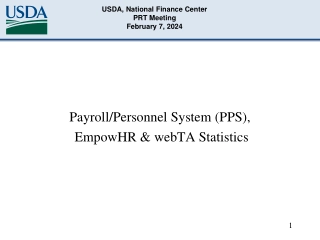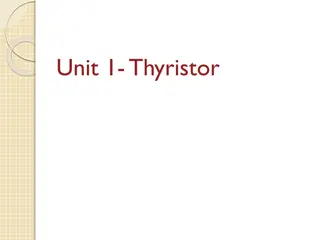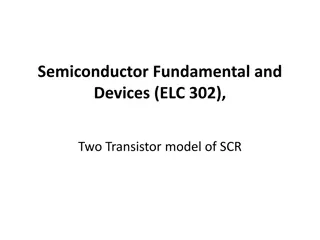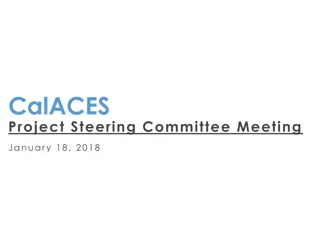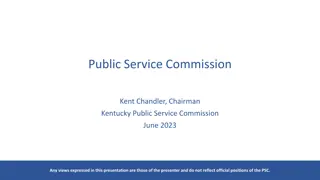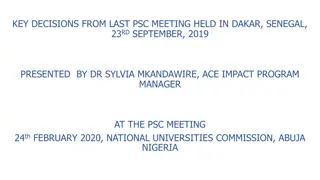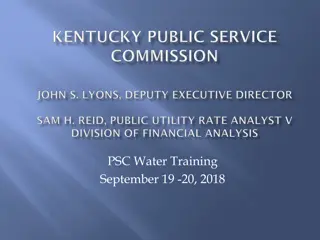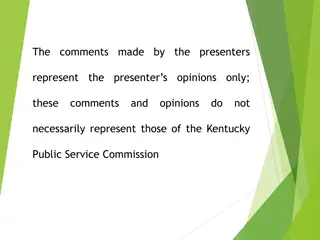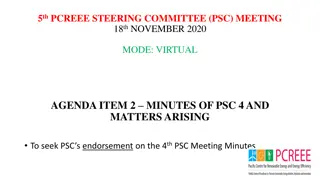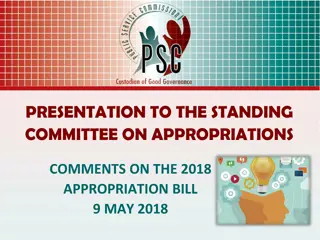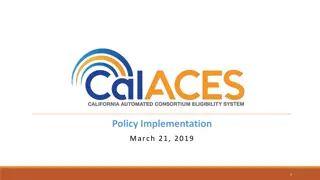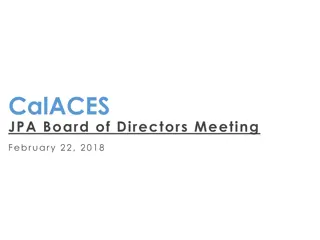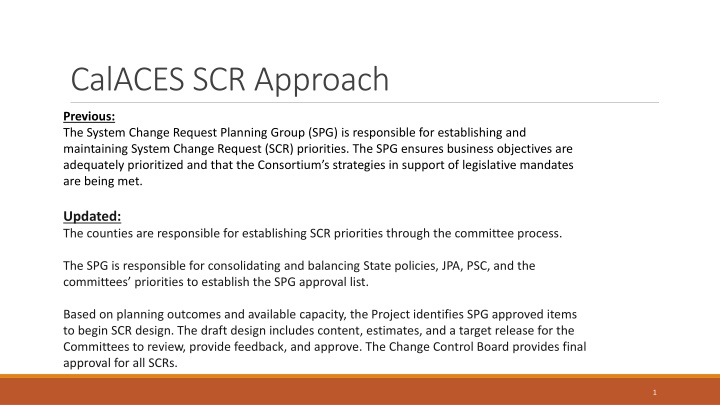
County SCR Prioritization and Design Process
The responsibility for prioritizing System Change Requests (SCRs) has shifted to counties, with committees playing a key role in determining SCR priorities and approving release dates. Counties can integrate design considerations earlier in the process by extending the design review period and initiating regular check-ins with committees. The process includes collaboration between committees, Consortium Analysts, and the Change Control Board to ensure transparency and efficiency in the SCR lifecycle.
Download Presentation

Please find below an Image/Link to download the presentation.
The content on the website is provided AS IS for your information and personal use only. It may not be sold, licensed, or shared on other websites without obtaining consent from the author. If you encounter any issues during the download, it is possible that the publisher has removed the file from their server.
You are allowed to download the files provided on this website for personal or commercial use, subject to the condition that they are used lawfully. All files are the property of their respective owners.
The content on the website is provided AS IS for your information and personal use only. It may not be sold, licensed, or shared on other websites without obtaining consent from the author.
E N D
Presentation Transcript
CalACES SCR Approach Previous: The System Change Request Planning Group (SPG) is responsible for establishing and maintaining System Change Request (SCR) priorities. The SPG ensures business objectives are adequately prioritized and that the Consortium s strategies in support of legislative mandates are being met. Updated: The counties are responsible for establishing SCR priorities through the committee process. The SPG is responsible for consolidating and balancing State policies, JPA, PSC, and the committees priorities to establish the SPG approval list. Based on planning outcomes and available capacity, the Project identifies SPG approved items to begin SCR design. The draft design includes content, estimates, and a target release for the Committees to review, provide feedback, and approve. The Change Control Board provides final approval for all SCRs. 1
Counties Questions and Concerns on the SCR Process Counties Concerns Updated SCR Process Who is responsible for prioritizing the SCRs? SPG or the Committees? Committee determines if an CER will move forward to an SCR; Committee prioritize the SCR and determines if it should go on the Committee Priority List 1 How can the counties design considerations be integrated earlier in the Design process instead of during the 2 weeks Committee Design Review step? Two weeks is not long enough to review the SCR Design Two weeks after SPG approval, Consortium Analysts will reach out to the committee to solicit input for design considerations. Inform committee when Design starts. Recap design considerations gathered from committee. Schedule regular check-ins with committees Extended design review period from 2 weeks to 3 weeks 2 When is the committee approving the release date for their SCRs? The Design packet sent to the Committees for review will include design content, release date, and estimates How does a County request for implementation request of urgent SCRs? Who and how is urgent defined? Start with the committee escalation when possible. The Escalation process will include escalation by PSC/RPMs to the project from JPA or PSC to Consortium Deputy Director(s) Refer to CalACES Escalation Process slide Counties want more transparency into the SCR life cycle Committee SCR List will include status; and release date and score when available Regular check-ins with Committees 3 3 2
SCR Lifecycle 1. CalACES Enhancement Requests 2. System Change Requests 5. Change Control Board (CCB) Packet 3. Design Collaboration 4. Design and Target Release 6. SCR Implementation (SCRs) (CERs) County PPOC submits CER Request Form to CER@calaces.org Consortium Analyst creates SCR once CER is approved, and communicates SCR # to County requestor. SPG approval authorizes Design Team to begin Design. Consortium will confirm the SCRs the Design Team is working on Design Team and Consortium Analyst complete draft Design Consortium Analyst submits CCB Packet (SCR Design) to Counties Project completes Build and Test activities for SCR 3 Regional ACL Input can be forwarded to ACLInput@calaces.org anytime and copy appropriate RPMs. Build and Test Teams confirm solution and estimate; review capacity and target release RPMs release greenlight approval to deploy to production systems 3 Once prioritized, Consortium Analyst creates scorecard for the SCR to assign a weighted value and priority. Committee will see the SPG score in the Committee Prioritization Template 2 3 Counties distribute CCB Packet internally for review; Project will address questions/concerns Consortium Analyst informs Committee when Design starts and distribute design input and ACL Input received from the regions 2 Consortium Analyst reviews estimates, target release date, and submits draft Design to Committee for review and approval of the Design and release date (approx. 3 weeks) 3 Project distributes final Release Notes 1 day prior to deployment 1 Committee agrees to move CER forward to an SCR CCB (RPMs) approves CCB packet (design, release, funding) 3 SPG approves SCR to be added to the SPG approval list (target 150 SCR SPG approval list per system) 3 2 Committee determines if SCR should be on the Committee Priority List Note: CERS are not required for State policy, administrative & training changes 1 For Designs with large effort, Consortium Analyst and Design Team will conduct regular check-ins with the Committee 2 Legend: After SPG approval, Consortium Analyst will solicit design consideration input from Committee. Share ACL Input 3 Highlight current process New / revised process 3
Sample Standard SCR Timeline Committee Design Review: 3 weeks Design: 4+ weeks Build: 8 weeks Test: 8 weeks SCRB/CCB Review: 3 weeks Deploy to Production 26 weeks/6 months SCR Implementation based on when design completes: Standard implementation timeline for a 4 week design is approximately 26 weeks Complex enhancements with new policies will take longer; design will generally start earlier Some SCRs may go through priority release deployment due to the nature of the urgency to meet certain mandate dates Project will solicit design consideration input from committee after SPG approve the SCR and before Design starts. Includes 7 days for Counties to review the CCB Package (Final Design and Release Date prior to starting Build) 4
Implementation Timeline of Updated SCR approach Updated SCR Approach Rollout: September 2018: Review SCR approach with PSC Conduct Facilitator Refresher Meeting October 2018: Roll out updated SCR approach to the Project Consortium Leads and Analysts Roll out Accenture Application Development Team Conduct webinars with Counties (e.g., RPMs, PPOCs, RCMs, Committees, facilitators, etc.) November 2018: Transition to the updated SCR approach for future SCRs 5
SPG Scorecard Refer to SPG Scorecard handout PURPOSE: The purpose of the SPG Scorecard is used to prioritize the SCR based on a predefined weighted scale. This allows for consistent handling and prioritizing of requests. Change Request Information Summary: (include SCR # if available) (1) Change Request Type: If Other, Please Explain: (2) Reason for Request: If Other, Please Explain: (3) Potential Risk if not Implemented Timely: Business Impact Assessment SIX MONTHS PILOT: The SPG Scorecard will be piloted for six months In three months, SPG will review the scorecard and identify enhancements to the scorecard and process. Rollout revised SPG Scorecard (1) How many Counties are impacted by the Requested Change? (2) Does the requested change directly impact benefits provided to Recipients? (3) Approximate population impacted by this change request. Define population (i.e. cases, programs, applications, etc.): (4) Can the change be handled through a reasonable alternative procedure, business process change or training? If Yes to Question 4, briefly describe the alternative procedure: (5) What is the estimated Effective Date: Effective Date (MM/DD/YYYY): Migration Impact Assessment (1) What is the Migration Impact on the Requested Change? Please Explain: Information About this Request Submitter Name: Total Score: #N/A Priority: #N/A 6
Scorecard Calculation (1) Change Request Type: o Data Change o DSR (County) o Enhancement o Individual Data Change o New Policy o Operational o Policy Re-design BUSINESS IMPACT ASSESSMENT (4) Can the change be handled through a reasonable alternative procedure, business process change or training? o No o Yes (1) How many Counties are impacted by the Requested Change? o 0 o 1 o 2 20 o 21 39 o 40 (5) What is the estimated Effective Date: o In 0 3 Months o In 4 6 Months o In 7 12 Months o Over a Year from Now o Past Due (2) Reason for Request: o Committee Priority o County Specific Request o JPA/PSC Strategic Initiative o New Policy/Policy Redesign o Operational Necessity o Other Please Specify (2) Does the requested change directly impact benefits provided to Recipients? o No o Yes MIGRATION IMPACT ASSESSMENT (3) Approximate population impacted by this change request. o 0 500 o 501 2,000 o 2,001 10,000 o 10,001 50,000 o 50,000+ (1) What is the Migration Impact on the Requested Change? o Closes a Design Difference o Introduces a Minor Design Difference o Introduces a Significant Design Difference o No Impact - County/System Specific o No Impact Targeted for same release in C-IV/LRS o Partially Closes a Design Difference (3) Potential Risk if not Implemented Timely: o Potential Litigation o Impact to Customer o Increased Error Rates o In Litigation/Court Judgment o None o Resource Efficiency o System Performance 7
Scorecard SPG Priority Definitions SPG SCR Approval and Prioritization will be determined by considering many different factors. Some of these factors include percentage of cases/workers impacted, Policy compliance and effective date, availability of alternate procedures, and priority of the SCR relative to other changes that have been deemed necessary. CRITICAL 85-100 Work stoppage will occur and no alternative procedure exists OR Regulatory, Program Directive or Contractual Requirements will not be met. HIGH 70-84 High impact to Caseload and/or Workers OR Alternative Procedure requires excessive time, cost and/or resources. MEDIUM 45-69 Moderate impact to Caseload and/or Workers OR Alternative Procedure requires some increase in time, cost and/or resources. LOW 0-44 Minimal impact to Caseload and/or Workers OR Alternative Procedure in place with minimal time, cost and/or resources. Also considered nice to have and are useful to pad out a release. 8
CalACES Escalation Process Project Escalation Committee Escalation Process RCMs/WMs review request with Committee/Workgroup Occurs within a 2-3 week period RCM escalates to PPOC to discuss with RPM RPM discusses with other RPMs and Project Staff RPM takes issue to Project Deputy Director Executive escalation of urgent matters to Project Deputy Director with a .cc to respective RPM(s) Before next PSC meeting RPM goes to its region s PSC member PSC Meeting RPM & PSC member creates PSC agenda item Before next JPA meeting Project Director creates JPA agenda item JPA meeting JPA Board renders final decision After JPA meeting RPMs communicate final decision to County/Region/Committee 9

